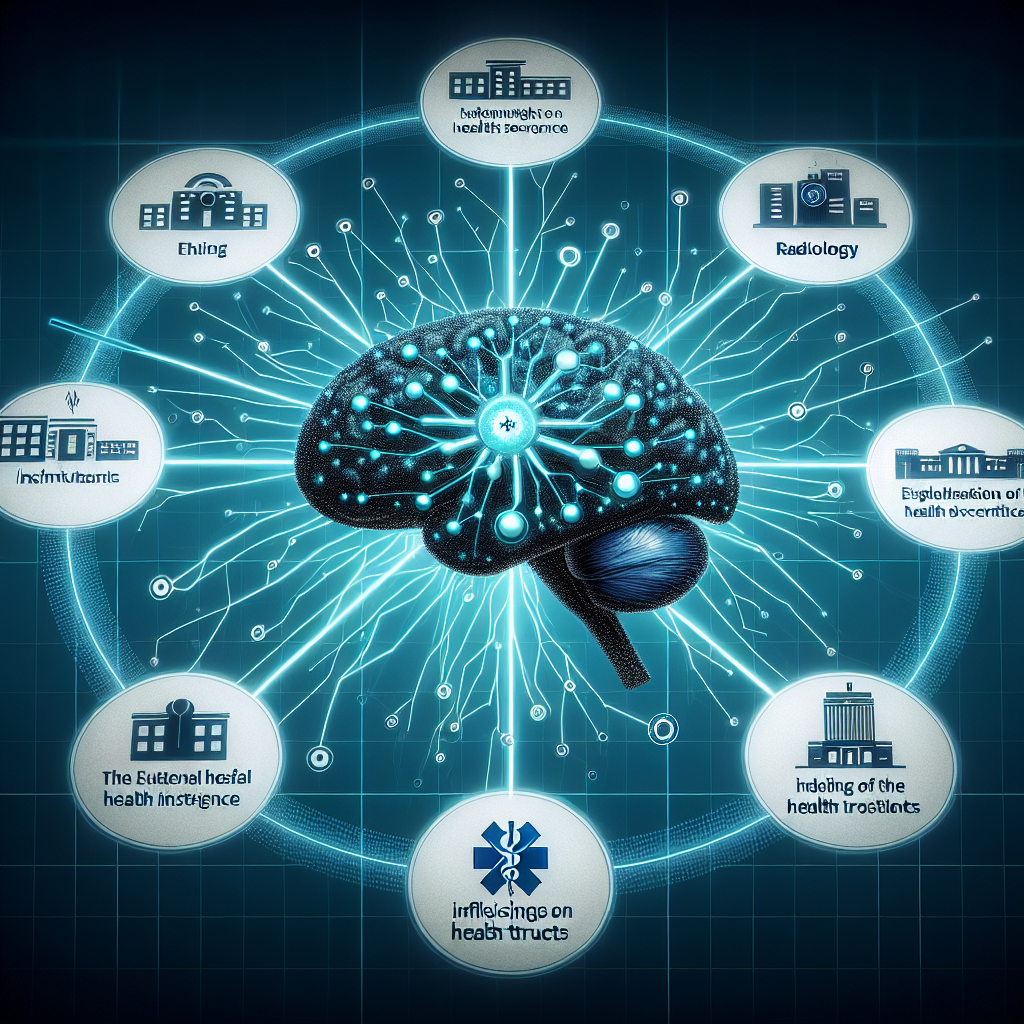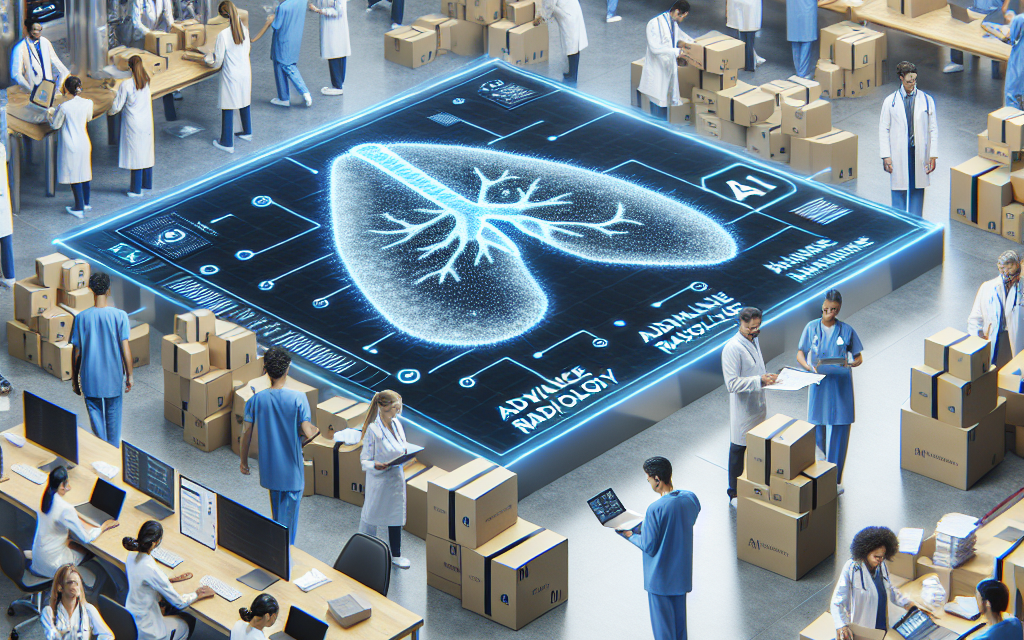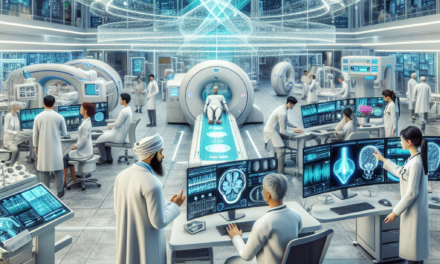NHS Expands Radiology AI to 10 Health Trusts

The National Health Service (NHS) in the United Kingdom has embarked on a transformative journey by integrating artificial intelligence (AI) into its radiology departments across 10 health trusts. This initiative aims to enhance diagnostic accuracy, reduce waiting times, and improve patient outcomes. As AI continues to revolutionize healthcare, the NHS’s adoption of this technology marks a significant milestone in modern medicine. This article delves into the various aspects of this expansion, exploring its implications, challenges, and potential benefits.
The Role of AI in Modern Radiology
Artificial intelligence has emerged as a powerful tool in the field of radiology, offering unprecedented capabilities in image analysis and interpretation. By leveraging machine learning algorithms, AI systems can process vast amounts of data quickly and accurately, identifying patterns and anomalies that may be missed by human eyes. This section explores the fundamental role of AI in modern radiology and its potential to transform healthcare delivery.
Enhancing Diagnostic Accuracy
One of the primary advantages of AI in radiology is its ability to enhance diagnostic accuracy. Traditional radiological assessments rely heavily on the expertise of radiologists, who must interpret complex images to identify abnormalities. However, human error is an inherent risk, and even experienced professionals can overlook subtle indicators of disease.
AI algorithms, trained on extensive datasets, can detect minute changes in imaging studies with remarkable precision. For instance, AI systems have demonstrated proficiency in identifying early-stage cancers, such as breast and lung cancer, by analyzing mammograms and CT scans. Studies have shown that AI can match or even surpass human radiologists in certain diagnostic tasks, leading to earlier detection and improved patient outcomes.
Moreover, AI’s ability to continuously learn and adapt enhances its diagnostic capabilities over time. As more data is fed into the system, AI algorithms become increasingly adept at recognizing patterns and refining their analyses. This iterative learning process ensures that AI remains at the forefront of diagnostic accuracy, providing radiologists with valuable insights to inform their clinical decisions.
Reducing Radiologist Workload
The integration of AI in radiology also addresses the growing challenge of radiologist workload. The demand for imaging services has surged in recent years, driven by an aging population and advances in medical technology. As a result, radiologists face mounting pressure to interpret a high volume of images within limited timeframes.
AI can alleviate this burden by automating routine tasks and prioritizing cases that require immediate attention. For example, AI algorithms can pre-screen images, flagging those with potential abnormalities for further review by radiologists. This triage system allows radiologists to focus their expertise on complex cases, improving efficiency and reducing the risk of burnout.
Furthermore, AI can streamline administrative processes, such as report generation and data entry, freeing up valuable time for radiologists to engage in direct patient care. By optimizing workflow and resource allocation, AI contributes to a more sustainable and effective radiology practice.
Improving Patient Outcomes
The ultimate goal of integrating AI into radiology is to improve patient outcomes. By enhancing diagnostic accuracy and reducing waiting times, AI can facilitate timely interventions and personalized treatment plans. Early detection of diseases, such as cancer, significantly increases the likelihood of successful treatment and long-term survival.
AI also plays a crucial role in monitoring disease progression and treatment response. Advanced imaging techniques, combined with AI analysis, enable clinicians to track changes in tumors or lesions over time, providing valuable insights into the effectiveness of therapies. This data-driven approach empowers healthcare providers to make informed decisions and adjust treatment strategies as needed.
Moreover, AI’s potential extends beyond diagnosis and treatment. Predictive analytics, powered by AI, can identify patients at risk of developing certain conditions, enabling proactive interventions and preventive measures. By shifting the focus from reactive to proactive care, AI contributes to a more holistic and patient-centered healthcare model.
Case Studies: AI Success Stories in Radiology
Several case studies highlight the successful implementation of AI in radiology, showcasing its transformative impact on healthcare delivery. One notable example is the use of AI in breast cancer screening programs. In a study conducted by Google Health, an AI model was developed to analyze mammograms and identify potential signs of breast cancer.
The results were promising, with the AI system demonstrating a reduction in false positives and false negatives compared to human radiologists. This breakthrough has the potential to revolutionize breast cancer screening, improving early detection rates and reducing unnecessary biopsies.
Another compelling case study involves the use of AI in detecting lung nodules on CT scans. Researchers at Stanford University developed an AI algorithm capable of identifying malignant nodules with high accuracy. The system outperformed radiologists in certain cases, highlighting its potential to enhance lung cancer diagnosis and treatment planning.
These success stories underscore the transformative potential of AI in radiology, paving the way for further advancements and widespread adoption across healthcare systems.
Challenges and Ethical Considerations
While the integration of AI in radiology offers numerous benefits, it also presents challenges and ethical considerations that must be addressed. One significant concern is the potential for bias in AI algorithms. If training data is not representative of diverse patient populations, AI systems may produce biased results, leading to disparities in healthcare outcomes.
To mitigate this risk, it is essential to ensure that AI algorithms are trained on diverse datasets that reflect the demographics of the patient population. Additionally, ongoing monitoring and evaluation of AI systems are crucial to identify and rectify any biases that may arise.
Another ethical consideration is the transparency and interpretability of AI algorithms. Radiologists and clinicians must understand how AI systems arrive at their conclusions to make informed decisions. Efforts to develop explainable AI models are underway, aiming to provide insights into the decision-making process and build trust among healthcare professionals.
Furthermore, the integration of AI in radiology raises questions about data privacy and security. The vast amounts of patient data required for AI training and analysis must be handled with the utmost care to protect patient confidentiality. Robust data governance frameworks and stringent security measures are essential to safeguard sensitive information.
Implementation Across 10 Health Trusts
The NHS’s decision to expand AI in radiology to 10 health trusts marks a significant step forward in the adoption of this technology. This section explores the implementation process, highlighting the key considerations and strategies employed to ensure a successful rollout.
Selection of Health Trusts
The selection of health trusts for the AI expansion was a carefully considered process, taking into account various factors such as infrastructure readiness, clinical expertise, and patient demographics. The chosen trusts represent a diverse cross-section of the NHS, encompassing both urban and rural areas, as well as different levels of healthcare provision.
This strategic selection ensures that the benefits of AI are accessible to a wide range of patients, regardless of their geographic location or socioeconomic status. By piloting the technology in diverse settings, the NHS can gather valuable insights into its effectiveness and scalability, paving the way for future expansion across the entire healthcare system.
Infrastructure and Technology Integration
Successful implementation of AI in radiology requires robust infrastructure and seamless integration with existing healthcare systems. The selected health trusts have invested in state-of-the-art imaging equipment and IT infrastructure to support the deployment of AI algorithms.
Collaboration with technology partners and AI developers is crucial to ensure that the systems are tailored to the specific needs of each trust. This includes customizing algorithms to align with local clinical protocols and workflows, as well as providing training and support for healthcare professionals to effectively utilize the technology.
Furthermore, interoperability between AI systems and electronic health records (EHRs) is essential to facilitate data exchange and streamline clinical workflows. By integrating AI into existing healthcare infrastructure, the NHS can maximize the benefits of this technology and enhance the overall efficiency of radiology services.
Training and Education for Healthcare Professionals
The successful adoption of AI in radiology hinges on the training and education of healthcare professionals. Radiologists, clinicians, and support staff must be equipped with the knowledge and skills to effectively utilize AI systems in their practice.
The NHS has implemented comprehensive training programs to familiarize healthcare professionals with AI technology and its applications in radiology. These programs cover various aspects, including the interpretation of AI-generated results, integration into clinical workflows, and ethical considerations.
In addition to formal training, ongoing support and mentorship are provided to ensure that healthcare professionals feel confident in their ability to leverage AI in their practice. This collaborative approach fosters a culture of innovation and continuous learning, empowering healthcare professionals to embrace AI as a valuable tool in patient care.
Monitoring and Evaluation
Continuous monitoring and evaluation are integral to the successful implementation of AI in radiology. The NHS has established robust mechanisms to assess the performance and impact of AI systems across the selected health trusts.
Key performance indicators (KPIs) are used to measure the effectiveness of AI in improving diagnostic accuracy, reducing waiting times, and enhancing patient outcomes. Regular audits and feedback loops ensure that any issues or challenges are promptly addressed, allowing for iterative improvements and refinements.
Furthermore, patient feedback is actively sought to gauge satisfaction and identify areas for improvement. By involving patients in the evaluation process, the NHS can ensure that AI implementation aligns with patient needs and expectations, ultimately enhancing the quality of care delivered.
Scaling and Future Expansion
The successful implementation of AI in radiology across 10 health trusts serves as a blueprint for future expansion across the NHS. The insights gained from this pilot phase will inform the development of best practices and guidelines for scaling AI adoption across the entire healthcare system.
As AI technology continues to evolve, the NHS remains committed to staying at the forefront of innovation. Ongoing collaboration with technology partners, researchers, and healthcare professionals will drive further advancements in AI applications, ensuring that the NHS remains a leader in delivering high-quality, patient-centered care.
Benefits of AI in Radiology for Patients and Healthcare Providers
The integration of AI in radiology offers numerous benefits for both patients and healthcare providers. This section explores the tangible advantages of AI adoption, highlighting its potential to transform healthcare delivery and improve patient outcomes.
Improved Diagnostic Accuracy and Early Detection
One of the most significant benefits of AI in radiology is its ability to improve diagnostic accuracy and facilitate early detection of diseases. By analyzing medical images with precision and speed, AI algorithms can identify subtle abnormalities that may be missed by human radiologists.
This enhanced diagnostic capability is particularly valuable in the early detection of cancers, such as breast, lung, and prostate cancer. Studies have shown that AI can reduce false positives and false negatives, leading to more accurate diagnoses and timely interventions.
Early detection is crucial for successful treatment outcomes, as it allows for less invasive interventions and increases the likelihood of long-term survival. By leveraging AI technology, healthcare providers can offer patients a higher standard of care, ultimately improving their quality of life.
Reduced Waiting Times and Increased Efficiency
The integration of AI in radiology has the potential to significantly reduce waiting times for diagnostic imaging and results. Traditional radiology departments often face backlogs due to high demand and limited resources, leading to delays in diagnosis and treatment.
AI can streamline the imaging process by automating routine tasks and prioritizing cases that require immediate attention. This triage system ensures that urgent cases are addressed promptly, reducing waiting times for patients and improving overall efficiency.
Moreover, AI can assist radiologists in generating reports and analyzing images more quickly, allowing them to focus on complex cases that require their expertise. By optimizing workflow and resource allocation, AI contributes to a more efficient and effective radiology practice.
Personalized Treatment Plans and Improved Patient Outcomes
AI’s ability to analyze vast amounts of data enables healthcare providers to develop personalized treatment plans tailored to each patient’s unique needs. By considering factors such as genetic information, medical history, and imaging results, AI can provide valuable insights into the most effective treatment strategies.
This personalized approach enhances patient outcomes by ensuring that treatments are targeted and optimized for each individual. For example, AI can help identify patients who are likely to respond well to specific therapies, allowing for more precise and effective interventions.
Furthermore, AI can monitor disease progression and treatment response over time, providing clinicians with real-time data to inform their decisions. This data-driven approach empowers healthcare providers to make informed adjustments to treatment plans, ultimately improving patient outcomes and quality of life.
Empowering Healthcare Providers with Advanced Tools
The integration of AI in radiology empowers healthcare providers with advanced tools and insights to enhance their practice. By automating routine tasks and providing valuable diagnostic support, AI allows radiologists to focus on complex cases that require their expertise.
AI also facilitates collaboration and knowledge sharing among healthcare professionals. By providing access to a wealth of data and insights, AI enables clinicians to make informed decisions and stay up-to-date with the latest advancements in medical research.
Moreover, AI can assist in training and education by providing radiologists with feedback on their performance and highlighting areas for improvement. This continuous learning process fosters a culture of innovation and excellence, ultimately benefiting both healthcare providers and patients.
Cost Savings and Resource Optimization
The integration of AI in radiology has the potential to generate significant cost savings for healthcare systems. By improving diagnostic accuracy and reducing unnecessary tests and procedures, AI can help optimize resource allocation and reduce healthcare costs.
For example, AI can reduce the number of false positives and false negatives, minimizing the need for additional imaging studies and invasive procedures. This not only reduces costs but also minimizes patient exposure to unnecessary radiation and interventions.
Furthermore, AI can streamline administrative processes, such as report generation and data entry, freeing up valuable time for healthcare professionals to focus on direct patient care. By optimizing workflow and resource allocation, AI contributes to a more sustainable and cost-effective healthcare system.
Challenges and Considerations in AI Implementation
While the integration of AI in radiology offers numerous benefits, it also presents challenges and considerations that must be addressed to ensure successful implementation. This section explores the key challenges and strategies for overcoming them.
Data Privacy and Security
One of the primary challenges in AI implementation is ensuring data privacy and security. The vast amounts of patient data required for AI training and analysis must be handled with the utmost care to protect patient confidentiality.
Robust data governance frameworks and stringent security measures are essential to safeguard sensitive information. This includes implementing encryption protocols, access controls, and regular audits to ensure compliance with data protection regulations.
Furthermore, transparency in data usage and consent is crucial to build trust among patients and healthcare providers. Clear communication about how data is collected, stored, and used is essential to ensure that patients feel confident in the security of their information.
Bias and Fairness in AI Algorithms
Bias in AI algorithms is a significant concern that can lead to disparities in healthcare outcomes. If training data is not representative of diverse patient populations, AI systems may produce biased results, leading to unequal access to care and treatment.
To mitigate this risk, it is essential to ensure that AI algorithms are trained on diverse datasets that reflect the demographics of the patient population. Ongoing monitoring and evaluation of AI systems are crucial to identify and rectify any biases that may arise.
Efforts to develop explainable AI models are also underway, aiming to provide insights into the decision-making process and build trust among healthcare professionals. By ensuring transparency and fairness in AI algorithms, healthcare providers can deliver equitable care to all patients.
Integration with Existing Healthcare Systems
Seamless integration of AI with existing healthcare systems is crucial for successful implementation. Interoperability between AI systems and electronic health records (EHRs) is essential to facilitate data exchange and streamline clinical workflows.
Collaboration with technology partners and AI developers is crucial to ensure that the systems are tailored to the specific needs of each healthcare provider. This includes customizing algorithms to align with local clinical protocols and workflows, as well as providing training and support for healthcare professionals to effectively utilize the technology.
By integrating AI into existing healthcare infrastructure, healthcare providers can maximize the benefits of this technology and enhance the overall efficiency of radiology services.
Training and Education for Healthcare Professionals
The successful adoption of AI in radiology hinges on the training and education of healthcare professionals. Radiologists, clinicians, and support staff must be equipped with the knowledge and skills to effectively utilize AI systems in their practice.
Comprehensive training programs are essential to familiarize healthcare professionals with AI technology and its applications in radiology. These programs should cover various aspects, including the interpretation of AI-generated results, integration into clinical workflows, and ethical considerations.
In addition to formal training, ongoing support and mentorship are provided to ensure that healthcare professionals feel confident in their ability to leverage AI in their practice. This collaborative approach fosters a culture of innovation and continuous learning, empowering healthcare professionals to embrace AI as a valuable tool in patient care.
Ethical Considerations and Patient Trust
The integration of AI in radiology raises ethical considerations that must be addressed to build trust among patients and healthcare providers. Transparency in AI decision-making processes is crucial to ensure that clinicians understand how AI systems arrive at their conclusions.
Efforts to develop explainable AI models are underway, aiming to provide insights into the decision-making process and build trust among healthcare professionals. By ensuring transparency and fairness in AI algorithms, healthcare providers can deliver equitable care to all patients.
Furthermore, patient engagement and communication are essential to ensure that patients feel informed and involved in their care. Clear communication about the benefits and limitations of AI technology is crucial to build trust and confidence among patients.
Future Prospects and Innovations in Radiology AI
The integration of AI in radiology is just the beginning of a transformative journey in healthcare. This section explores the future prospects and innovations in radiology AI, highlighting the potential for further advancements and improvements in patient care.
Advancements in AI Algorithms
As AI technology continues to evolve, advancements in AI algorithms are expected to enhance their diagnostic capabilities and accuracy. Researchers are exploring new techniques, such as deep learning and neural networks, to improve image analysis and interpretation.
These advancements have the potential to revolutionize radiology by enabling more precise and accurate diagnoses. For example, AI algorithms could be developed to detect rare diseases or identify subtle changes in imaging studies that may indicate early-stage conditions.
Furthermore, AI algorithms are being developed to analyze multi-modal data, such as combining imaging studies with genetic information or clinical data. This holistic approach has the potential to provide a more comprehensive understanding of a patient’s health and inform personalized treatment plans.
Integration with Other Medical Specialties
The integration of AI in radiology is not limited to imaging studies alone. AI has the potential to be integrated with other medical specialties, such as pathology, cardiology, and oncology, to provide a more comprehensive approach to patient care.
For example, AI algorithms could be developed to analyze pathology slides or genetic data, providing valuable insights into disease progression and treatment response. This integration has the potential to enhance collaboration among healthcare providers and improve patient outcomes.
Furthermore, AI can assist in clinical decision support by providing real-time data and insights to inform treatment strategies. By integrating AI across medical specialties, healthcare providers can deliver more personalized and effective care to patients.
Telemedicine and Remote Diagnostics
The COVID-19 pandemic has accelerated the adoption of telemedicine and remote diagnostics, highlighting the potential for AI to play a crucial role in these areas. AI algorithms can analyze medical images remotely, providing valuable diagnostic support to healthcare providers in underserved or remote areas.
This remote diagnostic capability has the potential to improve access to care and reduce disparities in healthcare outcomes. By leveraging AI technology, healthcare providers can offer high-quality diagnostic services to patients regardless of their geographic location.
Furthermore, AI can assist in remote monitoring of patients with chronic conditions, providing real-time data and insights to inform treatment strategies. This data-driven approach empowers healthcare providers to deliver proactive and personalized care to patients.
Collaboration and Knowledge Sharing
The integration of AI in radiology fosters collaboration and knowledge sharing among healthcare providers, researchers, and technology partners. By providing access to a wealth of data and insights, AI enables clinicians to make informed decisions and stay up-to-date with the latest advancements in medical research.
Furthermore, AI can assist in training and education by providing radiologists with feedback on their performance and highlighting areas for improvement. This continuous learning process fosters a culture of innovation and excellence, ultimately benefiting both healthcare providers and patients.
Collaboration with technology partners and researchers is crucial to drive further advancements in AI applications and ensure that healthcare providers remain at the forefront of innovation.
Regulatory and Policy Considerations
The integration of AI in radiology raises regulatory and policy considerations that must be addressed to ensure safe and effective implementation. Regulatory bodies play a crucial role in establishing guidelines and standards for AI technology in healthcare.
Efforts are underway to develop regulatory frameworks that address issues such as data privacy, algorithm transparency, and bias mitigation. These frameworks aim to ensure that AI technology is used ethically and responsibly, ultimately benefiting patients and healthcare providers.
Furthermore, policy considerations are essential to ensure equitable access to AI technology and address disparities in healthcare outcomes. By establishing policies that promote inclusivity and diversity, healthcare providers can deliver equitable care to all patients.
Conclusion
The expansion of AI in radiology across 10 NHS health trusts marks a significant milestone in the integration of this transformative technology into healthcare delivery. By enhancing diagnostic accuracy, reducing waiting times, and improving patient outcomes, AI has the potential to revolutionize radiology and transform patient care.
While challenges and considerations must be addressed to ensure successful implementation, the benefits of AI adoption are undeniable. By leveraging AI technology, healthcare providers can offer patients a higher standard of care, ultimately improving their quality of life.
As AI technology continues to evolve, the future prospects and innovations in radiology AI are promising. By fostering collaboration, knowledge sharing, and regulatory frameworks, healthcare providers can remain at the forefront of innovation and deliver high-quality, patient-centered care.





